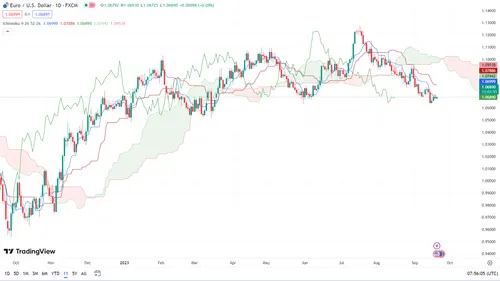Our partner, XM, lets you access a free demo account to apply your knowledge.
No hidden costs, no tricks.

Traders on the forex market use a variety of technical indicators to catch trends and make profitable trading decisions.
Technical indicators measure the volatility, trading volume, acceleration of trend movements, which makes it easier for traders to gather data from price movements on the market.
One such indicator is the Ichimoku Cloud. Developed in Japan in the 1930s, Ichimoku cloud has become a popular technical indicator outside of the country as well.
The Ichimoku Cloud provides a visual representation of several key elements on a price chart, helping traders assess various aspects of a market's price action and potential future trends.
The name is derived from the shape created by the lines, which resembles a cloud.
The Ichimoku cloud unites a number of indicators that gives traders a more comprehensive look at the price action on the chart to make adequate decisions and construct a consistently profitable forex trading strategy.
If you are a beginner trader that would like to know more about the Ichimoku Cloud indicator and how to use it in forex trading, this Investfox guide can help.
The Ichimoku cloud is a visual representation of several key elements on a price chart. The technical indicators that make up the Ichimoku Cloud include:
The Ichimoku Cloud overlays important data to traders regarding the price action on the chart. Ichimoku is a lagging indicator that helps traders assess the strength of the current trend and identify potential reversal points.
Here’s what the Ichimoku cloud shows:
To better illustrate how the Ichimoku Cloud works in forex, let’s look at an example of the indicator plotted on the EUR/USD price chart.

While a robust and complex indicator, the Ichimoku Cloud comes with its fair share of limitations. Considering these factors are crucial for traders to understand whether the indicator is beneficial for their trading objectives.
Our partner, XM, lets you access a free demo account to apply your knowledge.
No hidden costs, no tricks.
The Ichimoku Cloud consists of a conversion line, a base line, the Cloud, span A, span B, and the lagging span.
The crossings of the conversion and base lines with respect to the price line, determine whether the trend is bullish or bearish.
The Ichimoku Cloud generates bullish and bearish trend signals when the conversion line crosses above or below the base line. When the price also crosses above or below the base line, a buy/sell signal is reinforced.
While the Ichimoku Cloud offers a comprehensive look at the price action of an asset, it is a somewhat visually complicated indicator that some traders may find tedious.
The indicator may also sometimes generate false signals, which is something traders need to consider when using it.